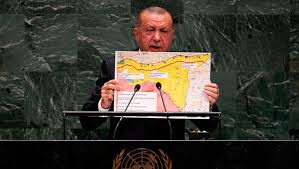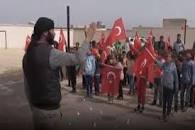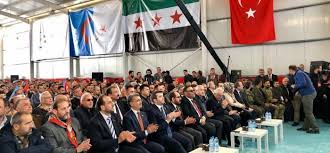[https://www.womendefendrojava.net]
The main purpose behind the invasion of northern and eastern Syria by the Turkish state and its gangs is to change the demographic structure of the region. Turkey has launched a war of aggression stating it wants to create a safe zone, and called these attacks “Source of Peace”. We know what that means from the massacre they committed in Afrîn under the name “Olive Branch”. Since then, hundreds of people have been killed in Afrîn, thousands kidnapped and tortured, olive groves and historical sites destroyed, hundreds of thousands forced to flee.
On the border of Idlib and Turkey, 120,000 people searching protection are trying to leave Syria. Turkey now sends soldiers to Libya, where the route of those leaving much of the African continent towards Europe converges.

Turkey wants to make the occupied areas a center where the worst kind of mercenaries are trained and sent to the world to commit atrocities. In this way, Turkey intends to blackmail Europe and the Arab states. Europe is only thinking of securing its borders, as long as the refugees do not reach European soil.
Erdogan and his gangs are aiming for a new demographic change with the “Salafi Turkish belt”, a new incarnation of the “Arab belt” created by the Syrian regime in 1962 to “de-Kurdify” the region,
The occupation poses the danger of ethnic cleansing and the threat of genocide.
As the population is driven out, Islamist families and people imported from the Turkish state are installed in its place.

The Turkish government tries to impose its neo-Ottoman interests through the Muslim Brotherhood. It has assembled dozens of different groups from al-Qaeda and the Muslim Brotherhood to use them to commit war crimes and as cannon fodder.
Already since the Adana agreement of 20 October 1998 between the Turkish state and the Syrian regime, in which they agreed that Turkey could chase “terrorists” up to five kilometers inside Syria, Turkish Secret Services began to invest in these groups.

Just a few weeks after the occupation of Serêkaniyê and Girê Spî, the “Turkification” of the region began.
The Directorate- General of the Turkish Migration Agency, coordinated by the Turkish Secret Service MIT, has started to prepare the resettlement of families from the “Turkish states” in Central Asia to the two cities of northern Syria.
MIT meets radical Islamists from so-called Turkish states such as Eastern Turkestan, Turkmenistan, Uzekistan, Tajikistan, Azerbaijan and even from Afghanistan, who have migrated to Turkey, to convince them to resettle.
First, pro-Turkish militia families are selected, the remains of Islamist groups such as IS and al-Nusra which Turkey calls the “Syrian National Army” (ENS).
On October 24, 2019, a meeting called “5th Congress of Turkmens in Syria” was organized in Turkish-occupied Azaz, by the Turkish state, to invite “Turkmen” to “return” to the occupied territories. During the meeting the delimitation of Turkmen territory in Syria was discussed, and even a flag and an anthem planned.

Turkey, as it has already done in Jarablus, Azaz, el Bab and Afrîn, is beginning to institutionalize the annexation of the areas it has occupied.
It has formed a “Syrian transitional government” and Turkish officials have been appointed as provincial presidents in Serêkaniyê and Girê Spî.

Serêkaniyê is known traditionally in by the names Waşokani, Aşukani, Kaniya Xezalan. The city has a history of settlement which dates back to the end of the Neolithic period. Tell Halaf, bordering Serêkaniyê, is considered to be one of the oldest settlements in the region.
Serêkaniyê is a city in which Armenians, Kurds, Arabs, Suryos, Chechens, Turkmen and Ezidis were living together. The population of Serêkaniyê (Ras al-Ain) has been living in peace for nine years. Girê Spî (Tall Abyad) and Serêkaniyê are examples of democratic self-organization and of the construction of a common and supportive life. Whereas now, in these cities, Turkish-jihadist occupation troops plunder and kill.
Turkish identity documents have been introduced, Turkish names are assigned to roads, villages and neighborhoods, and Turkish language has become a compulsory subject in schools. The same measures adopted by the “Islamic State” during its reign of terror are on the agenda.
They set up mercenaries with their families in the homes of the Kurds and other minorities, and seize their properties. All entry and exit routes have been closed to prevent residents from reaching their homes.
Due to the looting and destruction of infrastructure during the Turkish invasion, there are difficulties in the supply of primary goods such as water, bread and food. Food prices are spiraling out of control.
Invasion troops have blown up the houses of families from which people joined the Syrian Democratic Forces (SDF) and then flattened them with bulldozers.
Til Temir, symbol of the mosaic of peoples of Syria, is the next target of the attacks. Known as Little Syria, it has a multiethnic composition of Assyrians, Kurds, Arabs, Syriacs, Armenians, living together in the city. Until 2015, they lived peacefully together in this city, when IS attacked. IS tried to put the different peoples against each other, but this, on the contrary, strengthened their union. The goal of the Turkish state is to destroy the strength of this union.
Forced demographic change aims to weaken the democratic nation by depriving it of its roots and diversity.
The Christian minority in northern and eastern Syria, especially in the district of Til Temir (Tell Tamer) north of Hesekê, faces an existential threat from the Turkish jihadist invasion. The attacks aim to destroy the identity of the Syriacs (Aramaeans, (Armenians)Assyrians and Chaldeans) and their historical and cultural values.
Languages and cultures that for decades the Syrian regime tried to assimilate have reached official status in all institutions and organizations of the the Autonomous Administration of North and East Syria, especially in education.

Historical steps have been taken in the area of education in the region, giving everyone the right to receive education in their native language. The Kurdish, Chechen, Circassian, Syriac and Turkmen people, who had been deprived of their native language for years, have now started to develop their native language and teach it to their children.
Currently, more than 300,000 people are fleeing the attacks. As winter approaches a humanitarian catastrophe is imminent. The Autonomous Administration of North and East Syria set up the Waşûkanî camp in Hesekê, where more than 7,500 people reside.
Teacher Muhammed Haco is a member of the Administration Committee of Education of the city of Serêkaniyê. He too was forced to leave his city as it was occupied by the mercenaries of the Turkish occupation and is now part of the Administration Committee of Education in the Wasukani Refugee Camp. We discussed with him the demographic change and the assimilation and genocide plan, underlying the aggression of the Turkish state and its mercenary gangs.
“The Turkish state, along with its gangs, attacked the cities of Serêkaniyê and Girê Spî, as we all know, and as international public opinion knows, on 9 October. The Turkish state targeted these cities, where different people lived together in a democratic way, self-governing through local assemblies. It used heavy weapons, aerial bombing and even internationally prohibited weapons on a city as small as Serêkaniyê.
The result of these attacks is that thousands of people have been forced to migrate and have moved to the canton of Cizire, in particular to the Heseke’ area.
We are following the situation and, according to the information we have and what we have seen with our own eyes, the Turkish state wants to realize its plan to implement a demographic change project in the region.
We are now facing a situation where Serêkaniyê is no longer like a city of North and East Syria.

The Turkish state wants to transform it into another city, by giving it the name of Ceylaninar, has changed its administration and imposes its own language and culture on the population. The Turkish state has changed the name of 136 schools in the Serêkaniyê region to the names of characters from Ottoman history, who fought for the Ottoman Empire.
All the peoples who lived in the region according to a democratic system are well aware of the barabrity of the attacks by the Turkish state and its gangs and their massacres. They have seen what happened in Afrîn and have seen that now in Serêkaniyê and Girê Spî. The attacks are even more vicious and they cannot return to their cities, neither Kurds nor Arabs nor other peoples.
Turkish state propaganda claims that 1300 people have come back to the city of Serêkaniyê. It is true, 1300 people have gone to Serêkaniyê ,but 80% of these people come from Idlib. The people of Serêkaniyê have not come back, because they know and see the reality of the Turkish state gangs who now control the city.
They not only impose their own culture and language, they change the composition of the population of the region. The people who settled in Serêkaniyê don’t know the city, they don’t know the characteristics of the city and its traditions, the people who live in different neighborhoods don’t know each other, because they are all foreigners, in particular they are mercenary families of the Turkish state militias.
The Turkish state has completely alienated the city of Serêkaniyê from its people and regional culture.
At the same time, since the attacks began, those who suffered the consequences of these massacres have been mainly the civilian population. It is true that there has been strong resistance from our popular defense forces, YPG, YPJ and the SDF, but who was the victim of these attacks? Who was bombed with phosphorus weapons? The civilian population and the children of Serêkaniyê.
I, myself, that was part of the Education Committee in Serêkaniyê, saw with my own eyes, my children killed by the Turkish state. Four children studying in the school where I taught were killed, burned by the chemical weapons of the Turkish state and hit by their bombing. The photos of these children have been shown to international public opinion, but, unfortunately, the international institutions have remained silent in the face of these massacres.
The children who survived came to Heseke and we, as an education committee, had also no choice than to reorganise ourselves here in the refugee camp organized by the Autonomous Administration.
We said to ourselves, as before the attacks, our children studied and worked to build their future so now we will be by their side to continue doing it. So, a week after the October 9 attacks, we started the census of displaced children. At the beginning there were 1300 children and so we organized three different classes: preparation, intermediate and elementary.
In the camp classes were set up in tents, children study in both Kurdish and Arabic. Kurdish children study in their native language according to their own culture and history and so the Arab children, without interruption, because our goal is to counter the cultural genocide plan of the Turkish state.
Because the Turkish state plan was carried out so that our people, the population of Serêkaniyê, have been forced to live as refugees, to remain without education, so that, everyone would remain without a future, we want to block this plan of the Turkish state. So that he cannot say, I was successful in my plan in Serêkaniyê, in the future I will do the same in other regions.
If we look at Serêkaniyê today, the Turkish state has transformed 19 schools into military bases, razed 25 schools, changed the names not only of the remaining schools, but also of the hospitals, roads, has completely changed the identity of the city.
For this reason, the Turkish state is a danger for the whole world not only for the Kurdish people, this truth must be known. In particular the Turkish state is dangerous for the the entire Middle East, although its primary goal is the elimination of the Kurdish people. It is implementing a demographic change which has been forced upon in Serêkaniyê and Girê Spî as it did previously in Afrîn.

The region of Serêkaniyê, which previously was safe where all peoples lived together, has now become a dangerous area, because it has been occupied by the Turkish state and its mercenary militias and today in Serêkaniyê there is only one ethnic group, one language, one history, and they want to pursue their own cultural chauvinism.”
